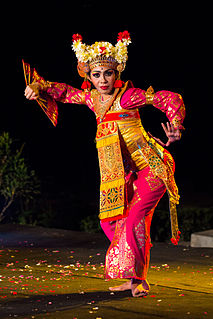
Bali is a province of Indonesia and the westernmost of the Lesser Sunda Islands. Located east of Java and west of Lombok, the province includes the island of Bali and a few smaller neighbouring islands, notably Nusa Penida, Nusa Lembongan, and Nusa Ceningan. The provincial capital, Denpasar, is the most populous city in the Lesser Sunda Islands and the second largest, after Makassar, in Eastern Indonesia. Bali is the only Hindu-majority province in Indonesia, with 83.5% of the population adhering to Balinese Hinduism.
Worship dance is any kind of dance that is undertaken for the specific purpose of religious worship.

Balinese Hinduism is the form of Hinduism practiced by the majority of the population of Bali. This is particularly associated with the Balinese people residing on the island, and represents a distinct form of Hindu worship incorporating local animism, ancestor worship or Pitru Paksha, and reverence for Buddhist saints or Bodhisattava.

Pendet is a traditional dance from Bali, Indonesia, in which floral offerings are made to purify the temple or theater as a prelude to ceremonies or other dances. Pendet is typically performed by young girls, carrying bowls of flower petals, handfuls of which are cast into the air at various times in the dance. Pendet can be thought of as a dance of greeting, to welcome the audience and invite spirits to enjoy a performance. It is one of the oldest Balinese dance, although the current form was codified in the 1950s.

Gamelan beleganjur is one of the most popular styles of gamelan music in Bali. Its closest Western analogue is probably the Western military band.

Nyepi is a Balinese "Day of Silence" that is commemorated every Isakawarsa according to the Balinese calendar. It is a Hindu celebration mainly celebrated in Bali, Indonesia. Nyepi, a public holiday in Indonesia, is a day of silence, fasting and meditation for the Balinese. The day following Nyepi is also celebrated as New Year's Day. On this day, the youth of Bali in the village of Sesetan in South Bali practice the ceremony of Omed-omedan or 'The Kissing Ritual' to celebrate the new year. The same day is celebrated in India as Ugadi.

Balinese dance is an ancient dance tradition that is part of the religious and artistic expression among the Balinese people of Bali island, Indonesia. Balinese dance is dynamic, angular and intensely expressive. Balinese dancers express the stories of dance-drama through the bodily gestures including gestures of fingers, hands, head and eyes.

Dance in Indonesia reflects the country's diversity of ethnicities and cultures. There are more than 300 ethnic groups in Indonesia: Austronesian roots and Melanesian tribal forms are visible, and influences ranging from neighbouring Asian and even western styles through colonisation. Each ethnic group has its own dances: there are more than 3,000 original dance forms in Indonesia. The old traditions of dance and drama are being preserved in the many dance schools which flourish not only in the courts but also in the modern, government-run or supervised art academies.

Pura Ulun Danu Batur is a Hindu Balinese temple located in the island of Bali, Indonesia. As one of the Pura Kahyangan Jagat, Pura Ulun Danu Batur is one of the most important temples in Bali which acted as the maintainer of harmony and stability of the entire island. Pura Ulun Danu Batur represents the direction of North and is dedicated to the god Vishnu and the local goddess Dewi Danu, goddess of Lake Batur, the largest lake in Bali. Following the destruction of the original temple compound, the temple was relocated and rebuilt in 1926.

A Hyang is an unseen spiritual entity that has supernatural power in ancient Indonesian mythology. This spirit can be either divine or ancestral. The reverence for this spiritual entity can be found in Sunda Wiwitan, Kejawen, and Balinese Hinduism. In the modern Indonesian this term tends to be associated with gods, devata, or God. The realm where the hyangs reside is called kahyangan; the abode of gods, now a synonym for svarga or heaven in modern Indonesian.

A pura is a Balinese Hindu temple, and the place of worship for adherents of Balinese Hinduism in Indonesia. Puras are built in accordance to rules, style, guidance and rituals found in Balinese architecture. Most puras are found on the island of Bali, where Hinduism is the predominant religion; however many puras exist in other parts of Indonesia where significant numbers of Balinese people reside. Mother Temple of Besakih is the most important, largest and holiest temple in Bali. Many puras have been built in Bali, leading it to be titled "the Island of a Thousand Puras".

Balinese architecture is a vernacular architecture tradition of Balinese people that inhabits volcanic island of Bali, Indonesia. The Balinese architecture is a centuries-old architectural tradition influenced by Balinese culture developed from Hindu influences through ancient Javanese intermediary, as well as pre-Hindu elements of native Balinese architecture.

Balinese traditional house refers to the traditional vernacular house of Balinese people in Bali, Indonesia. The Balinese traditional house follows a strict ancient architectural guide which is a product of a blend of Hindu and Buddhist beliefs, fused with Austronesian animism, resulting in a house that is "in harmony" with the law of the cosmos of Balinese Hinduism.
Wetu Telu is the traditional belief of the Sasak people of Lombok, Indonesia. Today the belief is centered around Bayan, a town north of Lombok, although it used to be widespread all over Lombok. It is a syncretic form of Islam which incorporates both Hindu and indigenous animist beliefs. Followers of Wetu Telu do not pray five times a day and some observe just three days of fasting during Ramadan.

A wantilan is a Balinese pavilion (bale) used for activities involving large crowds. A wantilan is the largest type of bale in Balinese architecture. A wantilan is basically a large wall-less hall placed under a large multi-tiered roof. A wantilan as a public building is usually located at a village's main square or main junction and functions as an open hall to hold large community activities such as meeting halls or a public musical gamelan performance. A wantilan is also a religious building, an integral part of Balinese temples used to hold the Balinese cockfighting ceremony.

Paduraksa, also known as kori is a type of gateway covered with towering roof that can be found in the island of Java and Bali, Indonesia. This architectural feature is commonly found in buildings from the classical Hindu-Buddhist period of Indonesia. Paduraksa marks the threshold into the most sacred space within a religious compound, a cemetery, or a palace. In Balinese architecture, an elaborately decorated towering paduraksa is often built as the temple's most imposing structure.

Pura Kehen is a Balinese Hindu temple located in Cempaga, Bangli Regency, Bali. The temple is set on the foot of a wooded hill, about 2 kilometres (1.2 mi) north of the town center. Established at least in the 13th-century, Pura Kehen was the royal temple of the Bangli Kingdom, now the Regency of Bangli.

Penglipuran Village is one of the traditional villages that located in Bangli Regency, Bali Province, Indonesia. Penglipuran village is famous as one of the tourist destinations in Bali because of its society who still preserve their traditional culture in their daily lives. The architecture of buildings and land processing still follows the concept of Tri Hita Karana, the philosophy of Balinese society regarding the balance of relations between God, humans and their environment. Penglipuran Village succeeded in building tourism that benefited all of their communities without losing their culture and traditions. In 1995, Penglipuran Village also received a Kalpataru award from the Indonesian Government for its efforts to protect the Bamboo Forest in their local ecosystem.

Rejang is a sacred Balinese dance, a sacrificial dance in which the girls offer themselves to the gods. It is usually held at the Hindu temple's of Klungkung Regency and Karangasem Regency in Bali, Indonesia. “Rejang” means “offering”, a dance to greet the gods that come down to the Earth. This dance is part of the sacred offering ceremonies, which all happen around about the same time on Bali’s ceremonial calendar.

Indonesian numismatic charms, also known as Indonesian magic coins, are a family of coin-like objects based on a similar Chinese family of coin charms, amulets, and talismans but evolved independently from them. Indonesian numismatic charms tend to have been influenced a lot by Hinduism, Islam, and the native culture and often depict religious imagery from Hinduism for this reason. The "magic coins" and temple coins from Indonesia are largely based on the Chinese cash coins introduced to the region during the Tang dynasty era in China, and during the local Majapahit era they began circulating in the region. Unlike with Chinese numismatic charms, the coin charms of Indonesia have not been as well documented both historically and in the modern era. A major modern day work about Indonesian numismatic charms in English is Joe Cribb's Magic coins of Java, Bali, and the Malay Peninsula which is a catalogue based on the collection of coin-shaped charms from the island Java acquired by Sir Thomas Stamford Raffles during his lifetime held in the British Museum, the book is further supplemented with data and information available from various other sources.

















